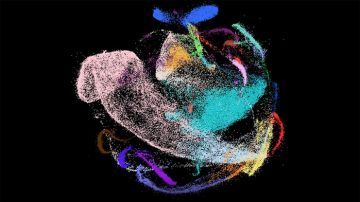Elizabeth Pannisi in Science:
 The National Institutes of Health’s (NIH’s) latest foray into turning emerging technologies into useful data sets is focusing on how the body’s trillions of cells interconnect and interact. The Human BioMolecular Atlas Program (HuBMAP) aims to describe the biochemical milieu and the locations of individual cells in the body’s major organs, researchers write this week in Nature. It uses technology heralded by Science as the 2018 Breakthrough of the Year. The goal is to “establish a baseline of what constitutes a healthy system,” says HuBMAP grantee Julia Laskin, an analytical chemist at Purdue University in West Lafayette, Indiana. That way, she says, researchers will be able to see what goes awry in disease. Until recently, biomedical scientists had just a broad-brush view of how organs functioned. In particular, they had succeeded in getting only a sense of gene activity—when genes turn on and off—in specific tissues. Gene activity defines what a cell does. But organs consist of many kinds of cells, each with their own molecular profiles.
The National Institutes of Health’s (NIH’s) latest foray into turning emerging technologies into useful data sets is focusing on how the body’s trillions of cells interconnect and interact. The Human BioMolecular Atlas Program (HuBMAP) aims to describe the biochemical milieu and the locations of individual cells in the body’s major organs, researchers write this week in Nature. It uses technology heralded by Science as the 2018 Breakthrough of the Year. The goal is to “establish a baseline of what constitutes a healthy system,” says HuBMAP grantee Julia Laskin, an analytical chemist at Purdue University in West Lafayette, Indiana. That way, she says, researchers will be able to see what goes awry in disease. Until recently, biomedical scientists had just a broad-brush view of how organs functioned. In particular, they had succeeded in getting only a sense of gene activity—when genes turn on and off—in specific tissues. Gene activity defines what a cell does. But organs consist of many kinds of cells, each with their own molecular profiles.
In 2016, drawing on technologies that enable researchers to routinely study individual cells, a group of 90 scientists from the around the world launched the Human Cell Atlas (HCA), which aims to catalog how cells operate in different tissues. The effort now involves 1500 scientists from 65 countries, and draws support from many sources, including the Wellcome Trust and the European Union’s Horizons 2020 program, says Aviv Regev, one of the HCA’s founding members and a computational systems biologist at the Broad Institute in Cambridge, Massachusetts.
HuBMAP represents the U.S. government’s commitment to this international grassroots effort, says the corresponding author on the 9 October Nature paper, genomicist Michael Snyder from Stanford University in Palo Alto, California. “Hopefully [HuBMAP] will have a major role in leadership and building the framework” that will help meld the HCA with about a dozen other projects focused on single cell analyses of specific organs, such as the brain, lungs, kidney, and pretumor and cancerous tissue, he explains. Such melding would involve establishing common standards, protocols, and ways of presenting the data. “As much as possible, we want to be able to compare apples to apples and oranges to oranges,” Snyder says.
More here.
